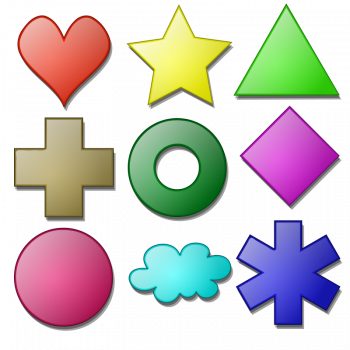
(Image from OpenClipart.)
You’ve got the colours, and now you need formerne (the shapes). 🙂
- You can certainly guess what cirkel [SEERkl] means. 🙂
- Streg [sdry] is a common word for linje [LINyeh] (line). When you’re drawing shapes, it’s hard to avoid streger. Some of them get together to make a vinkel (angle).
- In the Danish flag, two white bars cross and become a … kors (cross).
- A trekant [TREHkant] (”three-edge”) is a triangle, and I’m quite sure you know what the following words mean: firkant, femkant, sekskant…
- A firkant where all four sider (sides) are lige lange (”equally long”) is a kvadrat [kvahDRAAHT]. That word, however, is much less used in ordinary speech than ”square” in English. 🙂 Most of the times, firkant will do just fine.
- As in English, some shapes are named after things in the ”real world”: stjerne (star), halvmåne [HAL-MAWneh] (crescent), hjerte [YERteh] (heart).
Turning these nouns into adjectives (”description words”) is easy:
- Taget er trekantet. (The roof is triangular.)
- Flaget er firkantet. (The flag is rectangular.)
- Blomsten er stjerneformet. (The flower is star-shaped.)
- And oh, I almost forgot, round is … rund:
- Solen er rund. (The sun is round.)
Please note that the -et adjectives change their endig to -ede when in front of a definite noun or when describing plural nouns. (You know, those places where an ordinary adjective would get an –e!)
- Har du set det trekantede vindue? (Have you seen the triangular window?)
- Alle vores blomster er stjerneformede. (All our flowers are star-shaped.)
Finally, we need a mønster (pattern) for our tegning [TYE-ning] (drawing). 🙂
- Gardinet har prikker. Det er prikket. (The curtain has got spots on it. It’s spotted.)
- T-shirten har striber. Den er stribet. (The t-shirt has got stripes on it. It’s striped.)
- Nederdelen har blomster. Den er blomstret. (The skirt has got flowers on it. It’s flowered.)
- Sofaen har tern. Den er ternet. (The sofa has got squares on it. It’s chequered.)





